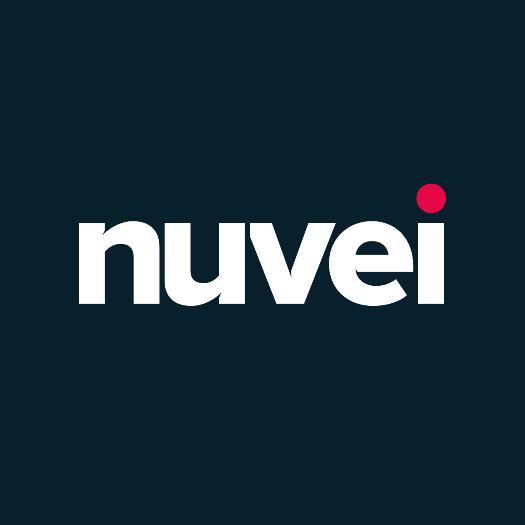

Partner Advisory Council
October 2025


Today’s Agenda
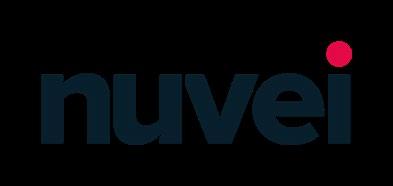
Time Session
9:00–9:10 AM Welcome
9:10–10:00 AM Emerging Disruptors: What Partners Need to Know (Glenbrook Partners)
10:00–10:50 AM Partner Playbook: Tech You Can Sell Today (Nuvei)
10:50–11:10 AM Break
11:10–12:00 PM
Beyond the Transaction: Best Practices and Next Steps for Embedded Payments (Nuvei + Glenbrook Partners)
12:00–1:00 PM Lunch & Networking
1:00–1:50 PM Navigating the Competitive Landscape: Lessons from Stripe (Glenbrook Partners)
1:50–2:40 PM Partner Success: Aligning for Impact (Nuvei)
2:40–3:00 PM Wrap-up
3:00–5:00 PM Happy Hour



Drew Edmond
Associate Partner, Glenbrook Partners, LLC

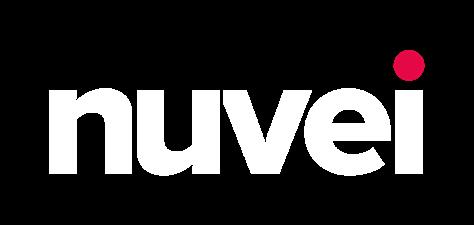
Emerging Disruptors:
What Partners Need to Know
About Glenbrook
Payments Strategy Consulting
- Clients are merchants, networks, PSPs, banks, fintechs, investors, etc.
Consulting Projects
- Payments Strategy
- Payments Research
- Payments Optimization
Payments Education
- Private Workshops for Execs, Product, Revenue and Account Management Teams
- Payments Boot CampTM Workshops
- Merchant Payments RoundtableTM
- Glenbrook Press












Macro Trends and Gen Z


2024 US Payments Systems Volumes

US 2024 Payments Systems
”Amount” as % of Total











Excludes Wires. Total count is 288 billion. Total amount is $127 trillion without Wires; $1,723 trillion with Wires. Debit includes general purpose, open-loop prepaid, and private label prepaid. Credit includes general purpose credit, private label credit, and oil cards. ACH and checks do not include on-us transfers. Fast includes RTP, FedNow, and Zelle. Cash
are consumer expenditures only.
Source: U.S. Federal Reserve; The Nilson Report; Nacha; The Clearing House; Early Warning Service; Glenbrook analysis, 2025
US Consumer Payments Trends
Big story over 15+ years is still the growth of debit
U.S.
Market Transaction “Count” 2008-2024






Source: The Nilson Report, Glenbrook Analysis, Mar 2025
Consumer Preference Trends
Consumers are starting to optimize their finances…

37% of US consumers select their payment method based on reward or financial gain – 63% don’t
38% of consumers have used BNPL; usage patterns reflect a shift from big-ticket to everyday spend
- 17% of US consumers have used BNPL for groceries
- 15% of US consumers have used BNPL for food delivery
40% of consumers said they were interested in an instrument that could toggle between debit, credit, and BNPL - 60% in the 25-44 age demographic
69% have used P2P for social spending and bill splitting
Source: Marqeta 2025 State of Payments Report, N=3,000 US & UK adults
Gen Z Payments Behavior
Could reflect the tip of the spear…
Credit cards – 81% of Gen-Z adults use regularly (up from 73% a year earlier); 47% pay off; 53% revolve; 28% pay less than half

BNPL – Gen-Z usage in Q1 2025 is 46% compared to 26% for the prior year
P2P Wallets – 93% of Gen Z consumers use Venmo, Zelle, or Cash App; 40% use them 5 or more times per month
Digital wallets – 81% of Gen-Z consumers use Apple Pay, Google Pay, or PayPal; 41% use these services 5 or more times per month
Wages – 62% of Gen-Z workers receive their pay in their bank accounts, 20% in their PayPal balances, 8% in their Venmo balances, and 34% expressed interest in “cryptocurrency”
Cash – For Gen-Z, cash usage is now just 7%
Card Network Update

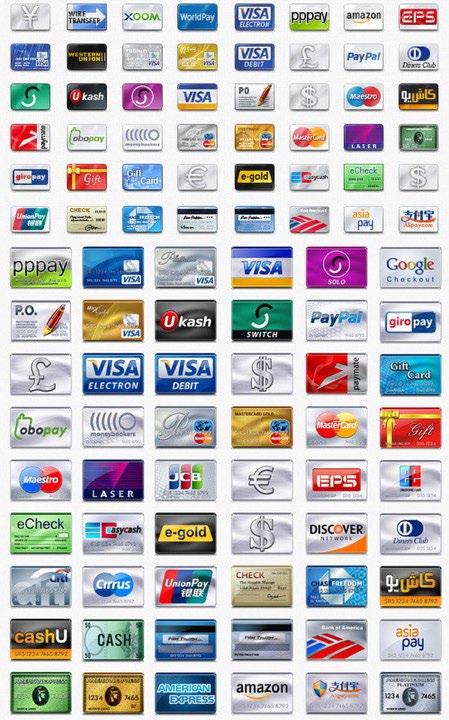
Cap One to Discover Portfolio Migration

New Capital One debit cards will be issued on Discover Network
Existing debit cards will migrate to Discover Network
- Impacts any Capital One customers with 360 Checking Account
- Same DDA, Same PIN, New PAN, New CVN2, and New Expiry Date
- 8.4 million new cards will be reissued; targeting EOY 2025 completion
New Capital One credit cards will issue on Discover Network in Q4 2025
Some existing credit cards will migrate to Discover in 2026-2027
Mastercard will handle changes through Mastercard card updater (batch)
No solution to token transition right now, existing CapOne Mastercard tokens will likely need to be reissued
New Discover cards will continue to refresh through Discover card updater
Visa CEDP: Meet the New Level II/III

Visa’s new compliance program targeting Level II and Level III data integrity
Visa will now validate enhanced commercial card data –submission of junk data no longer allowed!
Merchants must enroll in the program and have their data verified by Visa before enrollment
Merchant fees of 5bps per transaction apply
Key program milestones throughout 2025 with legacy Level II and III programs being sunset by April 2026
Visa CEDP: Practical Advice
Merchants should first verify their eligibility by receiving a verification report from Visa via their acquirer
After data remediation efforts are completed, final verification and program enrollment activities can be performed
Ongoing compliance must be monitored – merchants will lose interchange benefits if they are not
Key Program Milestones

April 2025: Program go-live. Merchants should start receiving data integrity notifications.
October 17, 2025: New interchange rates take effect; merchants must be verified by this date to qualify for the Product 3 rates
April 17, 2026: Visa will phase out its legacy Level II interchange program for Commercial and Small Business cards, except for the Fleet fuel-only Level II program
Tokenization Update
Tokenization growth continues at a strong rate

“Tokenization is growing at tremendous speed.”
13.7 billion tokens issued since program launch in 2014
Now issuing 1 billion tokens per quarter
1 billion+ tokens now issued in Latin America
50% of online transactions are now tokenized

“Impact on fraud levels and approval rates is significant.”
35% of all transactions are now tokenized
In Europe, 50% of e-commerce transactions are tokenized
Now claiming 3% to 6% authorization rate uplift
Standing by their 2030 plan to eliminate manual entry of PANs

Tokenization: Foundational and Critical to Many Use Cases

Card networks view tokenization as critical ”plumbing” to drive new technologies and strategic efforts
• Visa Intelligent Commerce
• Mastercard Agent Pay Agentic Commerce
• Visa Tokenized Asset Platform (VTAP)
• Mastercard Multi-Token Network (MTN) Blockchain
• Click to Pay Online Checkout
• Google Pay and Apple Pay
• Mastercard Token Authentication Service (Passkeys) Authentication
The Birth of Agentic Commerce



Agentic Commerce
AI agents are getting ready to go shopping on your behalf in tomorrow’s AI-centric world.


Source: Akira AI
Agentic commerce aspires to leverage the power of AI to help people shop, compare, make recommendations, and pay for purchases with minimal involvement
Killer Use Cases: Consumer Convenience
- Stand in Line
- Track Price/Availability
- Repeat Purchases
Consortiums are developing to establish standards for buyers/agents and sellers
Agentic models are being tested
Image
Personal Assistant and Personal Shopper
AI tools will learn preferences and act as a curator and payment executor when certain conditions are met

Curation
• Active usage today
• Multi-criteria shopping (e.g., vacation)
• MCP not required, but can create better results
• Can enable HP and HNP payments
Human Present
• Ideal when parameters are more complex
• Enable “one-click” purchases across multiple vendors
• Voice commerce 2.0?
Human Not Present
• Best when parameters are precise
• Price hunting and deal execution; concert tickets, dinner reservations, price drops on specific items
Increased Risk
Potential Agentic Models

Purchases can be completed in-session with a user present or autonomously via the agent
Retailer -Owned
Affiliate
Facilitation
The retailer owns and manages the agent and processes end-to-end
The AI agent finds products for consumers then sends them to a merchant website to complete the purchase
The AI agent finds a relevant product for the consumer. The consumer never leaves the agent’s shopping service to complete the purchase.
Marketplace or Merchant of
Record Model
The AI search platform operates as the end-to-end marketplace, facilitating payments, chargebacks and (potentially) customer service issues/returns
Sources: Glenbrook Analysis, Forrester, Commerce Ventures
Google Agent Payments Protocol (AP2)

Diverse set of stakeholders contributed to an open protocol and industry standard to enable agentic payments across payment methods
The protocol helps to address some of the major challenges in Agentic Commerce using cryptographically signed Mandates
Key Challenges
- Authorization: Proof that the agent is authorized to make a purchase
- Authenticity: Match merchant’s expectations to user intent
- Accountability: Determine accountability in the case of fraud or mistakes
Intent Mandate
A digitally signed instruction from user describing what the agent is permitted to do
Cart Mandate
Formal approval to lock in prices and items for a transaction
Agentic Commerce
Glenbrook’s Take

Consumer usage of agentic payments is essentially zero right now, as the payments experience is extremely clunky
Expect a mix of payment methods to be used, as consumers will continue to desire choice of payment type, though some may emerge as more prevalent in certain use cases
The industry is coalescing into groups/consortia that are attempting to develop protocols, schemas, standards, layers, technology. Consider joining a group if you want to influence the design or evolution
The “retailer-owned” agentic model likely to be first to expand, as it is easier to control the payments experience and is essentially just an evolution of personalization/recommendation engines that exist today
For merchants, adjusting back-office operations now is premature, other than ensuring bot activity can be monitored to ensure risk vectors are controlled appropriately
Opportunity for Growth in Embedded Finance


ISVs With Embedded Payments Will
Generate the Most Acquiring Revenue

This demonstrates SME acquiring matriculation from traditional acquiring to ISVs
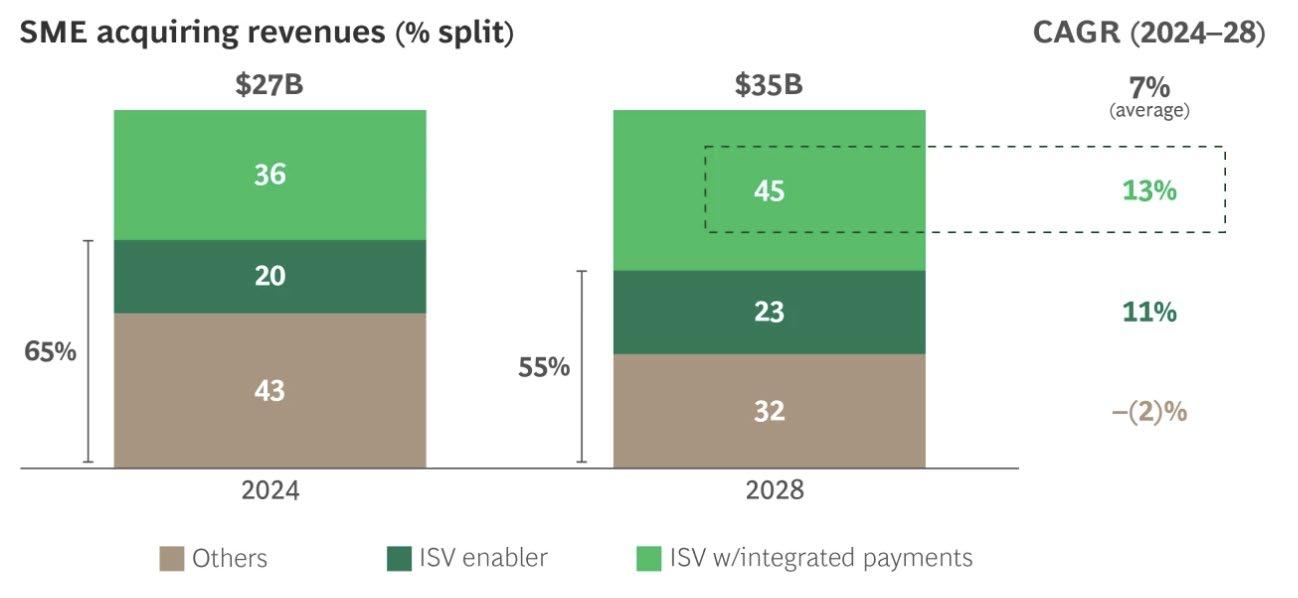
ISV’s with integrated payments, as a whole, will generate the most revenue from SME merchant acquiring in 2028
>50% of ISVs in North America offer embedded payments within their SaaS platforms
SME adoption of vertical SaaS solutions grew from 50% to 59% from ‘22-’24
Payments is a Proven Embedded Product

Additional financial services have seen much more limited attach rate

Capital, Accounts, and Issuing have massive opportunities from growth for ISVs, but this will require taking share from Financial Institutions serving SMEs
SMEs Still Use Banks for Financial Services


Firms look to different funding sources depending on credit risk
8 in 10 firms use a bank as their primary financial services provider
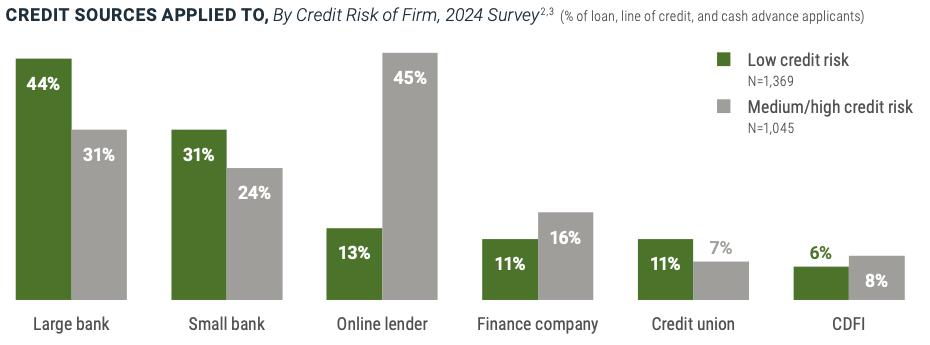
Source: 2025 Fed

Loan Applications to Large Banks Dipped in 2024
37% of surveyed firms applied for loans, lines of credit, or merchant cash advances

Passkeys and VAMP


What Are Passkeys?
How Passkeys Work Passkey Benefits
Eliminates passwords
Simplifies user experience
Faster sign-in to wallets, websites and apps
Greater authentication success rate
Lower exposure to phishing attacks
Less vulnerability to data breaches

Creation: a pair of cryptographic keys; one public, one private is generated; the public key is stored with the service (like Visa or Mastercard), while the private key is bound, securely, to the user's device
Authentication: the service sends a challenge that the device signs using the private key, confirming the user's identity without transmitting sensitive information
Secure Access: accessing the private key on the device is protected by device-level security (biometrics, PIN, or pattern)
Network Passkeys
Glenbrook’s Take

In markets where SCA / 3DS is mandated, passkeys provide a lower-friction alternative and enhance other authentication methods
In markets where 3DS is optional, consumer preference for and familiarity with biometrics over passwords and OTPs may encourage greater deployment of digital authentication, especially if liability shift is available
Click-to-Pay provides an applicable use case, but passkeys are not a prerequisite…
… merchants can choose to leverage network passkeys elsewhere (albeit potentially limited to tokenized credential use cases)
The ability to streamline consumer onboarding (and the role that issuing banks can play) will have a material impact on the pace of adoption
It’s possible for merchant to have a passkey strategy without having a network passkey strategy!
Visa VAMP Update

VAMP Advisory period started on April 1, 2025

Enforcement period started on October 1, 2025 (Confirmed by Visa – no postponements)
Initial Merchant VAMP Ratio Fine Threshold: 2.2%
Merchant VAMP Ratio Fine Threshold reduces to 1.5% on April 1, 2026
Penalties of $8 per transaction, plus additional potential fines and fees for noncompliance
Acquirers have their own portfolio-level threshold, which is significantly lower than merchant thresholds
Merchants Voice VAMP Challenges

As the enforcement period commences, many merchants continue to express frustration with elements related to the program
Access to Data
• Merchants are reporting challenges in obtaining key TC-15 and TC-40 data files from acquirers
Data Unknowns and Disparities
• Unanswered VAMP “status inquiries”
• Acquirer reporting often does not match TC15 or TC-40 data
Acquirer Enforcement
• Unknowns about how acquirers will enforce the program, particularly given their portfolio-level thresholds
Cross-MID Visibility
• Will Visa’s acquirers correctly calculate ratios across multiple MIDs?
Stablecoins for Merchants


Digital Currency Evolution
Physical cash is trending digital
Cryptocurrency
Stablecoins
Value fluctuates in market
Value does not fluctuate
CBDCs

Supply and demand determines exchange rate to fiat currency

Optimized for investing
Stablecoins are pegged to and backed by assets or currency
Value does not fluctuate
CBDCs are fiat currency issued by the central bank
Optimized for payments
Optimized for payments
Privately owned
Community owned
Examples - Bitcoin, Ethereum, Solana, etc.
Examples – Tether, USD
Coin (USDC), etc.
Government owned
Examples – e-RMB, Sand
Dollar
What Are Stablecoins Being Used For

Primary use cases are for crypto trading, emerging market wealth protection, and cross-border money movement
Safe Haven Currency
Consumers and businesses in emerging markets can protect their wealth by converting their currency into stablecoins pegged to a stable currency like USD
Trading
Used as a settlement currency for traders moving funds from one cryptocurrency to another
Stablecoins enable nearinstant, 24/7 international transfers with lower fees than remittance services
Stablecoins
Glenbrook’s Take

Consumer-to-business payments may be the slowest use case to take hold, especially for buyers in developed countries
More likely to see enterprise businesses incorporate stablecoins for B2B supplier payments and payout/disbursements before pay-ins
Regulatory fragmentation, dollarization, and financial sovereignty concerns in other countries may slow growth





On-Demand Payments Education
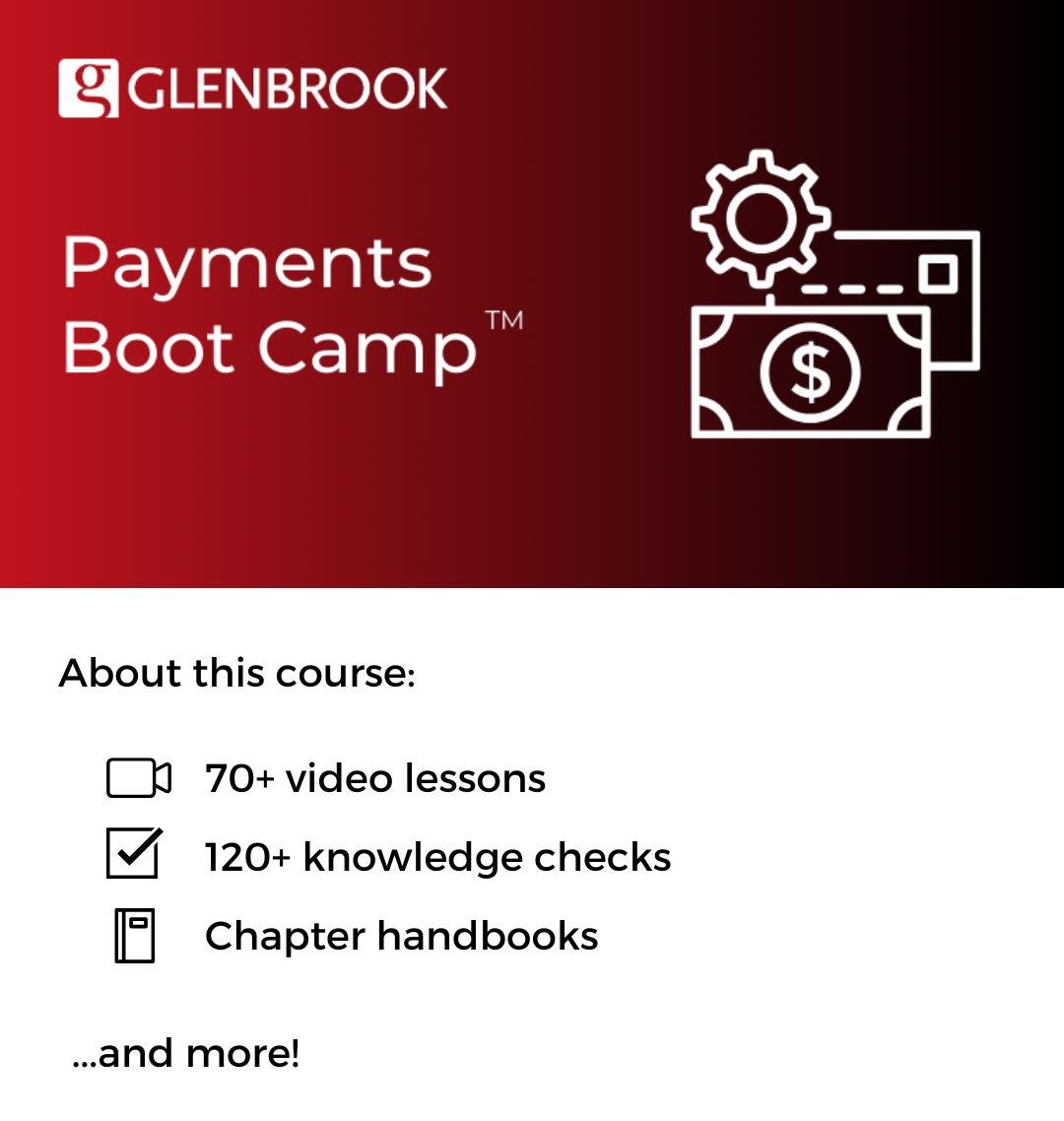






http://www.glenbrook.com/education



Drew Edmond



Rebecca Mergner
VP, B2B Product


Comprehensive B2B Suite
Empowering partners to automate, monetize, and scale payments
Commerce Suite
Unified payments and finance platform for ERPs and ISVs
Seamless bidirectional ERP integration
Automates AR, AP, and financing in one environment

AR Automation
Accelerate receivables and reduce DSO
Enable self-service invoicing and payments
Simplify collections and reconciliation
AP Automation
Optimize vendor payments and cash flow
Eliminate pre-funding and manual invoice handling
Automate approvals, scheduling, and reconciliation
AR Financing
Convert invoices into working capital
Access on-demand liquidity and stabilize cash flow
Integrated within the Commerce Suite for simplicity
Nuvei Commerce Suite
Transforming how finance teams work — from payments to cash flow optimization

Simplify your Tech
Stack
Unified payments + finance platform
Works standalone or with any ERP
Reduces system complexity and data silos
Maximize cash conversion
Accelerate receivables & optimize payables
Unlock working capital with AR/AP automation
Enable AR financing to improve liquidity
Do more with less
Automate workflows end-to-end
Minimize manual effort and errors
Drive efficiency across finance ops
Enhance visibility & control
Real-time ERP sync for accurate GL postings
Built-in compliance and fee recovery tools
Gain transparency across all transactions
Nuvei Commerce Suite empowers ISVs and enterprise platforms to deliver smarter, more connected financial operations.
Nuvei AR Automation
Get paid faster, lower costs, and improve customer experience
Get paid sooner
Digitized invoicing and multiple payment options eliminate delays
Anonymous payment links and customer portal simplify payments
Automated reminders speed up collections
AR financing unlocks cash flow early
Control costs
Automation minimizes manual work and reduces invoice processing expenses
Optimize payment terms and discounts through ERP integration
Integrated surcharging enables compliant fee recovery and cost control
Enhance Customer Experience
Self-service dashboard centralizes invoices, payments, and receipts
Multiple payment options with scheduling and recurring capabilities
Securely stored payment methods streamline future transactions

Boosts efficiency
Automate reconciliation and eliminate manual data entry
Payments and adjustments post automatically to ERP
Operate within existing ERP workflows — no disruption or retraining
Nuvei AR Automation: Streamline receivables, reduce DSO, and improve liquidity through automation.
Nuvei AP Automation
Optimize vendor payments and cash flow
Let your money work for you
Turn faster payment cycles
Improve vendor experience

Boost efficiency
Direct ACH payments on processing day keep cash available longer
Extend payables strategically while maintaining vendor relationships
Sync invoices from ERP to streamline approvals and payments
Pre-validated vendor information ensures payment accuracy
Automate payments and scheduling directly within ERP
Early payment automation helps capture discounts and optimize cash flow
Vendors access invoices, payouts, and updates via selfservice portal
Real-time payment status tracking enhances communication
Automated reconciliation reduces disputes and errors
Automation reduces manual intervention across payments
Integrated workflows minimize delays and exceptions
Improved accuracy lowers processing costs and cycle time
Nuvei AP Automation: Simplify vendor payments, improve accuracy, and optimize working capital.
Nuvei AR Financing
Bridge Cash Flow Gaps With On-Demand Capital
Convert invoices into Working Capital
Access funds faster to improve liquidity
Turn receivables into immediate, predictable capital
Eliminate cash flow uncertainty
Flexible financing ensures reliable access to cash
Stabilize operations and reduce dependency on traditional credit cycles
Increase financial agility
Real-time forecasting and cash flow visibility
Improve decision-making with instant access to funding metrics

Streamline AR operations
Financing, payments, and reconciliation unified in one platform
Seamless ERP connectivity simplifies end-to-end cash management
Nuvei AR Financing: Unlock liquidity, stabilize cash flow, and simplify financial operations.
Nuvei Commerce Suite
Flexible Integration for Every ERP and Business Model
Adaptable by Design
• Works seamlessly with cloud, on-premises, and hybrid ERP environments
• Built to support diverse business models and partner ecosystems
• Provides consistent performance and reliability across deployment types
Integration Made Simple
• Pre-built APIs, SDKs, and plug-and-play connectors accelerate time-to-value
• ERPs and ISVs can embed payments directly within existing workflows
• Reduces integration effort and ongoing maintenance costs

Legacy ERP’s that do not have capability to go through PM are direct to gateway

Financing ISVs have option to go direct to gateway ERPs are direct to PM for gateway access or direct to gateway based on ERP
Middleway is gateway access
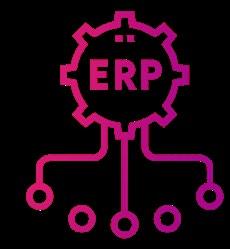







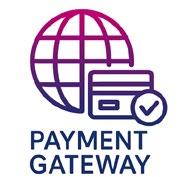
Nuvei enables ERPs and ISVs to integrate payments effortlessly — delivering adaptability, speed, and scale.
Seamless ERP Integration
Connect payments directly into leading ERP platforms for faster reconciliation and smoother financial workflows.






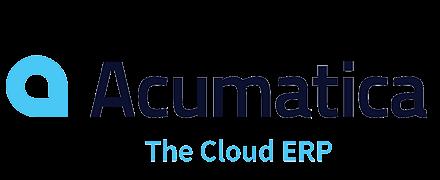








Nuvei Partner Value Proposition
Driving Growth for Partners Through Commerce Suite
For ISVs
• Embed payments and finance natively – provide end-to-end automation
• Increase merchant retention and engagement through AR/AP and cash flow solutions
• Monetize transactions and financing to unlock new revenue streams
• Seamless integration with pre-built connectors for faster go-to-market
• Expand offerings with end-to-end B2B payment automation (invoicing, collections, vendor payments)
• Reduce operational friction – automate workflows, lower DSO, and streamline cash flow management
• Increase merchant loyalty by recommending a scalable finance platform
• Gain a competitive edge with integrated financing and ERP automation
Nuvei enables partners to embed financial automation directly into their platforms and deliver modern finance solutions to merchants at scale.




VP, Integrated Partner Product Strategy and Customer Success Carin Obad


NUVEI BILL PAY
Why Nuvei Bill Pay
Nuvei Bill Pay is a billing and payment portal that helps you simplify operations, reduce friction, and deliver a seamless payment experience to consumers. When you are selling into field services, education, healthcare, or property management, Nuvei Bill Pay turns everyday billing into a competitive advantage.



Frictionless Payments – Bankcards, ACH bank transfers, Autopay, mobilefirst design
Multilingual & Scalable – English, Spanish, and easily extendable
Smart Account Tools – Manage account, bill viewing, and payment history
Text to Pay – Send bills via SMS, citizens pay in seconds
Automated Alerts & Notifications – Payment reminders, status updates, and past-due notices
Personalized Messaging – Tailored communications based on user preferences
Partial Payments – Flexible payment options for complex scenarios
eBilling– Paperless invoicing and payment workflows
IVR - Pay by Phone

Key Verticals


















NUVEI BILL PAY
Flexible Payment Experiences
From online portals to walk-up windows to assisted phone payments, Nuvei Bill Pay gives users the freedom to pay their way.

Remotely
Online payments | e-bill presentment | Email invoicing

In-person
Walk-in payments | Self-serve stations | Lock-box services

Assisted Live phone payments | Interactive - IVR | Automatic bill-pay








NUVEI BILL PAY
Optimizing Your Implementation
Our client management team’s proven methodology provides a structured process flow that’s consistent, reliable, and focused on empowering your success.
3-tier Citizen Rollout Plan
Pre-Launch
• Bill Pay announcements Deployment
• Bill Pay best practices and Q&A factsheets
Post-Launch
• Bill Pay adoption solutions

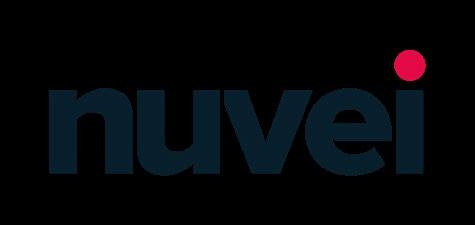
Key Benefits

Communication channel options

Multilingual dashboard
24/7 Account access & bill pay


Reliable & secure portal
Billing delivery mngmt
Multi-property account view
Easy, One-time payments

Recurring payments
Billing & statement history

















Beyond the Transaction: Best Practices and Next Steps for
Embedded Payments











President,
Hilly Productions
James Hilliard
Global Head of Partner Channel
Ben Weiner
Associate Partner, Glenbrook Partners, LLC
Drew Edmond



Drew Edmond
Associate Partner, Glenbrook Partners, LLC


Navigating the Competitive Landscape: Lessons From Stripe
Customer Segmentation and Fit
Enterprise: All-in-One vs. Point Solutions
Enterprises want control, not convenience
Perception gap: Large enterprises still associate it with startup and SaaS use cases
Pricing and flexibility: Enterprise merchants feel like they are paying for more than they use
Feature breadth vs depth: Stripe’s integrated stack is a strength for smaller merchants or platforms, but too bundled for enterprises that prefer point solutions or have equivalents
Orchestration is nascent: Enterprises may not want Stripe to retain visibility and control and the product is new
Structural Limits in Traditional Channels
Stripe’s model doesn’t map neatly to legacy ecosystems
A different white-label: Connect Custom lets platforms fully brand onboarding, payout, and reporting flow, but Stripe is still the PayFac of record. Platform does not own the merchant in the ISO sense
Residual model gap: Rev-share models exists (buy-rate basis), but lacks residual contracts
Hardware / POS depth: Stripe expanded third-party integrations but remains limited compared to multi-hardware acquirers
High-risk / specialty verticals: Stripe excludes many industries that ISO-centric providers serve
Control, Customization, and Risk
Stripe does not optimize for maximum flexibility
Risk control: Platforms cannot modify underwriting rules, funding delays, or chargeback criteria
3rd-party tooling: Stripe’s ecosystem is mostly closed; limited ability to plug in alternative fraud, lending, or KYC providers within the same flow
Surcharging: No native capabilities to support surcharging, though third-party partners exist to fill gap
Brand ownership: Stripe Connect Custom offers deeper control, but true underwriting autonomy remains centralized under Stripe’s PayFac license
Stripe’s Support Model for Platforms
Stripe’s Support Model
Self-service orientation through documentation and help portals
Support accessed via dashboard chat or email
No account management without paying for it
Reactive issue handling
Typical Platform Needs
Dedicated contact familiar with business operations
Proactive support, optimization, and quarterly reviews
Strategic and consultative engagement for onboarding and growth
Direct phone and email access
Considerations for Nuvei Partners
Stripe Constraints
Centralized control
Stripe owns KYC, risk, and compliance
Market Opportunities
Partner autonomy
Nuvei lets ISOs/ISVs manage merchants and underwriting
Flexible economics
Fixed pricing model
Limited margin and residual flexibility
Closed ecosystem
Limited third-party and tool integration
Custom buy-rates, rev share, and residual ownership
Open platform
Modular architecture and external integrations
API-first, enterprise-light
Minimal ERP or B2B depth
Narrow POS footprint
Few devices, Tap-to-Pay focus
Enterprise-grade orchestration
Routing, reconciliation, ERP readiness
Full omnichannel stack
Broad hardware and retail coverage
How Stripe Competes vs. Enables
Dimension Enables
Go-To-Market
Product Layer
Acts as the regulated PayFac and lets partners embed features in their own products
Provides APIs and compliance rails that partners build on top of
Economics
Control / Risk
Premium pricing, with revenue share available
Competes With
Strategic
Dynamic
Handles KYC, fraud, and funds flow
Sells directly to end merchant and verticals that partners target
Enabler of software-led payment distribution
Launches native products (Billing, Invoicing, Lending) that replicate what partners sell
No residuals, no ownership of MIDs
Centralizes control; can’t use alternate risk models or 3P providers
Competitor to legacy acquirers and fintech partners who want to own merchant relationships
Stripe Focused on Stablecoin Ecosystem
Cross-border capabilities through stablecoin infrastructure
Acquired Bridge to integrate stablecoin-based payment and treasury rails
Enables faster, lower-cost settlement across global markets
Expands Stripe’s reach beyond card networks into programmable money movement
Positions Stripe to compete in the emerging stablecointo-fiat transaction layer

Tempo: Stripe’s Blockchain for Payments
High throughput, low-cost global transactions
Payments First - Purpose built for stablecoin payments
Optimized for Scale
- High throughput
- Quick finality
Predictable, Low Fees - Compared to unpredictable “gas fees” that can spike
Pay Fees in Stablecoins
- No need for a separate token
Payments Lane
- Don’t get stuck behind other blockchain activity
Privacy - Supports use cases like payroll
Stripe Partner Directory
A curated marketplace showing companies that build on, integrated with, or provide services around Stripe’s platform; Not an ISO/reseller directory

• Professional services firms and SIs with a proven record of implementing Stripe
• Software platforms that embed Stripe (commerce, subscription, invoicing, marketplaces, vertical SaaS
• Prebuilt, ready-todeploy blueprints and integrations (connectors, templates, etc.)
Stripe Connect for Third Party Payments
Connect is Stripe’s infrastructure for platform payments, enabling ISVs and SaaS providers to onboard, accept, and pay out merchants in supported markets.
Offers Standard, Express, and Custom integration models with built-in KYC / AML / verification flows managed by Stripe for hosted or embedded onboarding.
Handles payment collection, routing, and fee-splitting across supported payment methods once account capabilities are enabled.
Powers scheduled, manual, and instant payouts (where available) while Stripe retains regulatory responsibility for compliance and fund settlement.
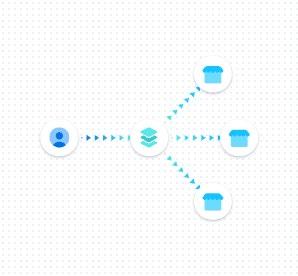
Stripe Connect Account Types
• Standard: The seller signs up directly with Stripe
• Express: Seller account under platform umbrella; Stripe-hosted onboarding UI
• Custom: Seller is a Stripe account, but fully white-labeled by the platform
Stripe Connect: Deep Dive
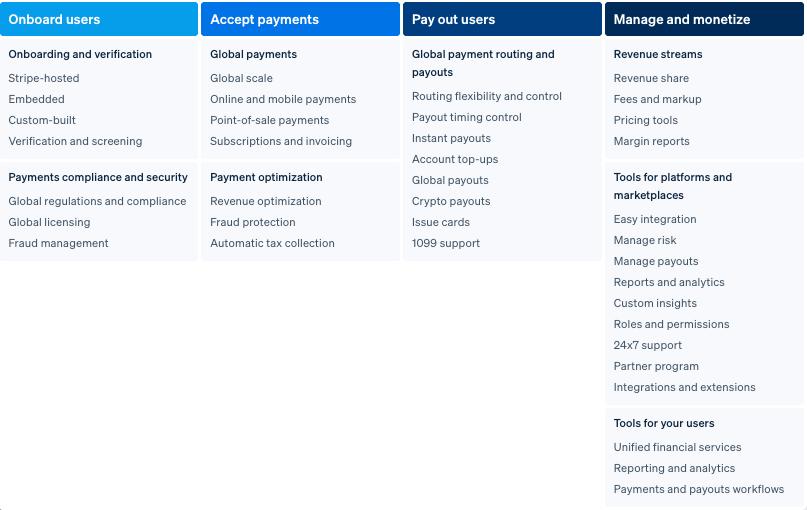
Stripe Terminal: POS Payments
Enables ISVs and SaaS platforms to embed in-person payment acceptance within their software.
Works with Tap to Pay and third-party POS integrations (FreedomPay, Cegid, Oracle Xstore) for omnichannel reach.
Provides single APIs and unified reporting across online and offline transactions.
Lets partners extend Stripe’s stack to retail without managing their own POS hardware or acquirer setup.
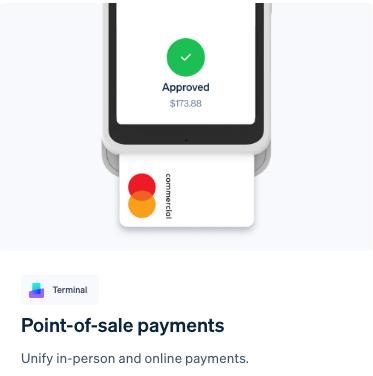
• Seamless shopping across channels
• No need for separate acquirers or recon systems by channel
• Offer in-store capabilities to merchants without building a full POS stack
Stripe Capital: Business Financing
Allows platforms and ISVs to offer embedded working-capital loans to their merchants.
Stripe handles risk, underwriting, funding, and compliance while the platform surfaces loan offers.
Merchants get fast, automated funding and repayment via sales volume.
Helps partners increase retention and payment volume without becoming lenders.

• Earn referral fees without holding credit risk
• Deepens merchant relationships and increases stickiness
• Funding drives more transaction activity, compounding payments revenue
Issuing and Managing Cards
Lets SaaS and ERP platforms create branded virtual or physical cards for expenses, payouts, or rewards.
Partners control card design and authorization logic; Stripe manages banking, networks, and compliance.

Integrates with Financial Accounts and Connect for programmatic balance funding.
2025 updates allow partnerowned banking relationships, giving ISVs more flexibility.
• Launch card programs without issuer bank relationships
• Keep capital cycling within the platform
• Enable controlled disbursements or expense management
Stripe Financial Accounts
Provides embedded account infrastructure so platforms can let users hold, send, and receive funds.
Backed by Stripe’s partner banks, handling custody, KYC, and compliance.
Enables multi-currency balances and global payouts via Stripe APIs.
Empowers ISVs and SaaS platforms to embed “banking” functionality without becoming financial institutions.

• Turns platforms into financial operating systems for their users.
• Captures float, transfer, and payout economics once money stays inplatform
• Increases merchant dependency and lifetime value through embedded accounts
Stripe Snapshot: 2025
Strong volume growth led by Ecommerce and Platforms
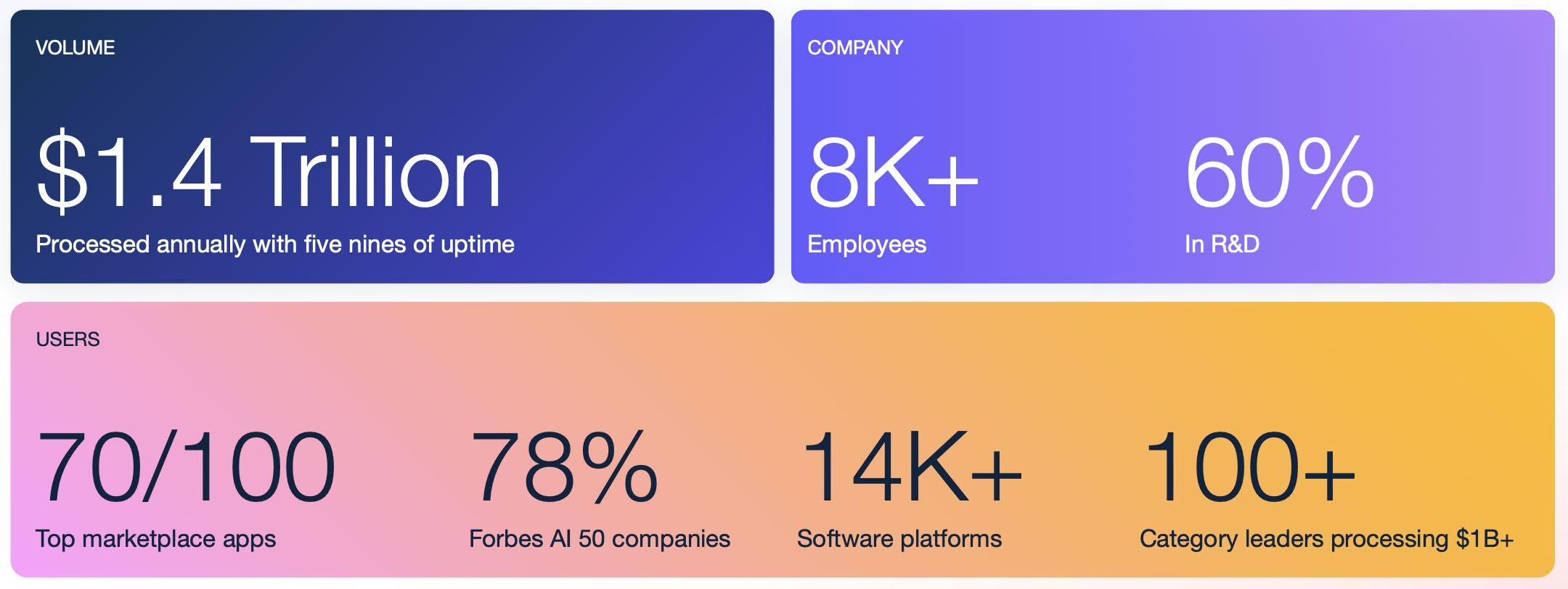
Platforms and marketplaces have been a priority since 2012 Enterprise has been a priority for 2+ years
Stripe’s Value Propositions
Financial infrastructure for the internet
- A complete economic stack: banking, lending, payouts, stablecoins
Develop first and API-driven
- Easy integration, technical documentation “as a product”
Unified and Modular Platform
- One-stop-shop, but pick-and-choose modules
Global reach and compliance-as-a-service
- Go global easily
Embedded Finance and new revenue streams
- Enable partners to monetize
AI-powered optimization and intelligence
- Smarter conversion and fraud tools
Stripe’s Unified, Modular Platform
• Online Payments
• Billing and Invoicing
• In-Person Payments
Onboarding
Issuing
Payouts
• Tax
• Payments Intelligence
• Reporting and Data
Monetization
Capital
Financial Accounts
Platform Management
Stablecoins
Partner Success: Aligning for Impact





Evan Zach
VP, Partner Success



Bridget Eurich
Head of Partner Success
Partner Success Evolution











Partner Success Teams

PARTNER SUCCESS
Manages daily operations and aims to improve overall satisfaction in support of our indirect channel partners in North America and beyond.
PARTNER SUPPORT
Manages support requests for a wide variety of issues including system access, equipment and account change requests.
PARTNER SUCCESS
OPERATIONS
Drives operational efficiency across the organization, leading initiatives to maximize operational effectiveness and improve efficiency.
Dawn Martinez Partner Success Operations
Durcell Lundy Director, Partner Support
Christine Poliquin Head of Partner Success
Bridget Eurich Head of Partner Success
Partner Success Support Model

We have redefined and segmented We have redefined the service model to align

Gold Gold
Silver
Bronze
Key Initiatives

Cross Training

• Success and support team members from Nuvei, Paya and Till
• System access
• Cross training team to support across previous entity lines –removing silos

Automation Projects


• Driving process efficiency, optimization, AI and automation whenever possible
− Daily reports Weekly reports Reduce inefficiency


• 100% of support requests now run through a centralized ticket management system
• All cases tagged by consistent categories to allow tracking by case type which allows us to provide guidance on expected turnaround
• Established support and relationship survey processes to capture transactional and overall partnership satisfaction
• Detailed reporting enabled for top partners

Priority Management

• Partnership Improvement Management
• Identifying, tracking and executing on ways to improve overall partnership
• Success Model cascaded to all Nuvei
• Continuously working to ensure proper prioritization of internal service and support for top partners
• Aligning geographical regions
KPI Development & Reporting


